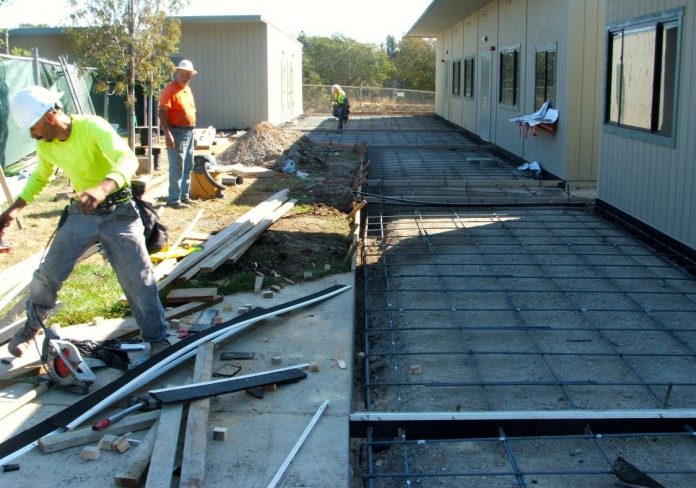
GILROY— A Fresno court case threw six Gilroy school building projects worth $3.2 million into chaos days before construction was to start, cost taxpayers more than $500,000 extra and delayed one project indefinitely.
The ruling in Davis vs. Fresno Unified School District upended how districts have avoided using competitive bidding to build new schools and facilities for 58 years, a system called lease-leaseback, and is likely to be precedent-setting statewide, according to experts.
Among the planned Gilroy Unified School District projects were the overhaul of the Gilroy High School Stadium track and field and new classrooms for the district’s Gilroy Early College Academy (GECA) at Gavilan College.
School officials say they were taken by surprise when they learned on June 8 of the ruling three days earlier by a state appellate court in Fresno.
“We felt like we were hit by a bus. It was the absolute worst time for it to happen,” said Alvaro Meza, the district’s assistant superintendent for business services.
That’s because six building projects funded by Measure P and for which lease-leaseback contracts had been signed were set to begin that week.
“As soon as we learned, we were on the phone with legal counsel to develop a game plan to make sure we could still go forward, but we knew we were going to take a (financial) hit,” Meza said.
The Fresno ruling was not binding on Gilroy, but trustees and staff huddled with the contractors and, out of “an abundance of caution,” terminated the six contracts and put the projects out for competitive bidding, according to Meza.
That’s because the Fresno case opened the door to lawsuits statewide, including possibly against Gilroy schools and its contractors, if their lease-leaseback deals strayed from what’s allowed under the 1957 law passed to help poor districts pay for projects over four decades and avoid competitive bidding.
If the district lost such a suit it would not itself suffer financially, but its contractors would be forced to repay the district all costs it had collected for the projects, as happened in Fresno.
Here’s why: under lease-leaseback, schools lease land to contractors for $1, the project is built at the contractor’s expense and when it’s completed the land and improvements are sold back to the district, which pays it off over four decades, a sort of long-term mortgage.
Gilroy’s $158 million Christopher High School and others were built under lease-leaseback, but are not impacted by the Fresno ruling.
However, in Fresno, the district used a controversial alternate form of lease-leaseback not spelled out in the 1957 law. Rather than pay over 40 years, it paid in full when the project was completed. And when it did, another contractor sued saying that violated the lease-leaseback law and stymied the competitive bidding process.
As a result of the ruling, the builder now must pay the district back $37 million it cost to build a middle school.
Gilroy’s concerns focused not only on the need for the projects to be completed and the use of Measure P bond money, but also on the well-being of its contractors, according to Meza.
“Putting hard working people at risk of bankruptcy is not good business,” he said, explaining the district took the path it did in part to protect its contractors.
At least one school board member, however, did not agree with that approach.
“The court decision was not binding on us, it was a different judicial district,” trustee Mark Good, an attorney, told the Dispatch. “My preference would have been to press forward” with the original lease-leaseback contracts, he said.
Although some formal bids came in lower and some higher than the original contract prices, the total cost of the projects rose from $3.2 million to $3.7 million, a $500,000 increase, and that was for just five of the projects.
One project, upgrading acoustics in Building G at Gilroy High School, was dropped for lack of funds and has been put on temporary hold, according to Meza. Under lease-leaseback it’s cost was $430,000. The formal, rejected bid was $755,000.
In the case of the Gilroy High School track and field project, the original contract was $1.23 million, which rose to $1.48 million when put out to bid.
The other projects and their lease-leaseback and accepted formal bids are as follows: GECA, $340,000 vs. $309,000; Gilroy Prep School classrooms, $453,000 vs. $461,000; Rucker School, $256,000 vs. $282,000; Antonio Del Buono multipurpose room, $484,000 vs. $435,000.
GILROY UNIFIED SCHOOL DISTRICT BY THE NUMBERS
Students K-12: 11,850 projected for 2015-16; 11,840 in 2014-15
Teachers: 511 teachers 2015-16; 500 in 2014-15
Principals: principals: 15; assistant principals: 7
Other professionals: nurses, 5; psychologists, 8; counselors, 8; academic counselors, 7; mental health therapists, 2; program specialists, 2
Non-certificated staff: food service, 58; maintenance, 74; transportation, 25; technology, 6; miscellaneous, 11; campus supervisors, 22; clerical, 114; paraeducators, 154; translators, 2
Employees in district office: 52
Total number of district employees: 1044 (501 classified, with 50% full-time, 50% part-time; 543 certificated, with 95% full-time, 5% part-time)
Annual payrolls: 2014-15: $81,992,938; 2015-16: $90,965,419
Total expenses: 2014-15: $138,420,582; 2015-16: $119,348,700
Source: GUSD













